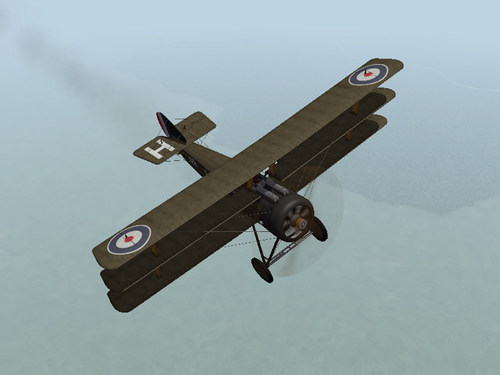
The Sopwith Triplane, also known as the "Tripe" or "Tripehound," was introduced at the end of 1916. By mid 1917, several British and French naval squadrons were equipped with the plane. The narrow chord of the three staggered wings gave the pilot an excellent field of view and gave the plane an exceptional rate of climb as well as outstanding agility. The Triplane was considered an exceptional fighter and stayed in service until replaced by the Sopwith Camel in late 1917. Captured Sopwith Triplanes inspired the development of the more famous Fokker Dr.1.
My model of the Sopwith Triplane has the smaller tail assembly introduced early in 1917. Earlier planes had a larger tail plane nearly identical to the tail of the Sopwith Pup. Most Triplanes were equipped with a single Vickers machine gun mounted on the fuselage. A small number of Sopwith Triplanes had two guns. This is the two gun version.
My Sopwith Triplane has a skin, with appropriate decals, for the "Black Flight" of the RNAS 10 squadron. Note - these skins are NOT interchangeable with the skins for my other Sopwith Triplanes.
A fully functional cockpit is included, along with my skinning templates. I have included a sound file for the Clerget 130 hp engine, but you may already have it.
Credits
Although he's very busy these days, Ojcar found the time to make the FM for this plane. My thanks to him.
The sound file included with this plane came with Sinbad's series of Sopwith Strutters, so you may already have it. I included it with this download in case you don't.
Historical Note
The Black Flight had five planes, each with its name painted at the cockpit. I have added 15 fictitious names in order to complete the decal set.
Installation Instructions
For FE1 - Unzip the file and move the folder named "SopwithTripe2Gun" into the FirstEagles/Objects/Aircraft folder.
My Triplane uses the sound file that came with Sinbad's series of Strutters, so you may already have it. If you don't, copy the file named "RotaryEngineClerget130" from my Sounds folder into your FirstEagles/Sounds folder.
For FE2 - Unzip the file and move the folder named "SopwithTripe2Gun" into the FirstEagles/Objects/Aircraft folder. Then in the FirstEagles/Objects/Decals folder, create new folder named "SopwithTripe2Gun". Move the folder named "D" from the Aircraft/SopwithTripe2Gun folder into the Decals/SopwithTripe2Gun folder you just made.
My Triplane uses the sound file that came with Sinbad's series of Strutters, so you may already have it. If you don't, copy the file named "RotaryEngineClerget130" from my Sounds folder into your FirstEagles/Sounds folder.
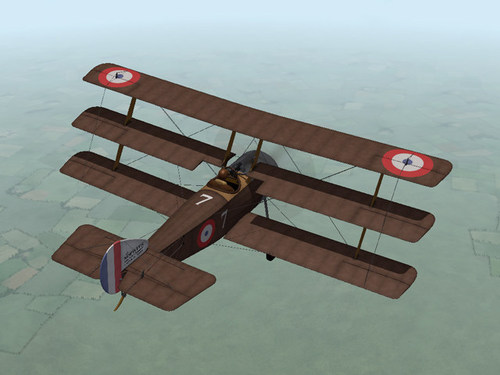
The Sopwith Triplane, also known as the "Tripe" or "Tripehound," was introduced at the end of 1916. By mid 1917, several British and French naval squadrons were equipped with the plane. The narrow chord of the three staggered wings gave the pilot an excellent field of view and gave the plane an exceptional rate of climb as well as outstanding agility. The Triplane was considered an exceptional fighter and stayed in service until replaced by the Sopwith Camel in late 1917. Captured Sopwith Triplanes inspired the development of the more famous Fokker Dr.1.
The first planes produced had a tail plane nearly identical to the tail of the Sopwith Pup. Early planes also had a 110hp Clerget engine. A smaller tail plane was introduced early in 1917. The engine was also replaced with a more powerful 130hp Clerget engine.
This is an early version of the Sopwith Triplane with a wider tail and lower powered engine. It has two skins, one French and one British, with appropriate decals. Note - these skins are NOT interchangeable with the skins for my other Sopwith Triplanes.
A fully functional cockpit is included, along with my skinning templates. I have included a sound file for the Clerget engine, but you may already have it.
Credits
Although he's very busy these days, Ojcar found the time to make the FM for the early Sopwith Triplane. My thanks to him.
I have included a sound file for the Clerget engine created by Nixou. It has been used on other planes, so you may already have it. I included it with this download in case you don't.
Historical Note
The 110 hp Clerget engine was the 9Z. I don't have a sound file for the 9Z so I used a sound for the Clerget 9B instead.
Installation Instructions
For FE1 - Unzip the file and move the folder named "SopwithTriplane" into the FirstEagles/Objects/Aircraft folder.
I have included Nixou's sound for the Clerget engine. It has been used with other planes, so you may already have it. If you don't, copy the file named "clerget9b2m2" from my Sounds folder into your FirstEagles/Sounds folder.
For FE2 - Unzip the file and move the folder named "SopwithTriplane" into the FirstEagles/Objects/Aircraft folder. Then in the FirstEagles/Objects/Decals folder, create new folder named "SopwithTriplane". Move the folder named "D" from the Aircraft/SopwithTriplane folder into the Decals/SopwithTriplane folder you just made.
I have included Nixou's sound for the Clerget engine. It has been used with other planes, so you may already have it. If you don't, copy the file named "clerget9b2m2" from my Sounds folder into your FirstEagles/Sounds folder.
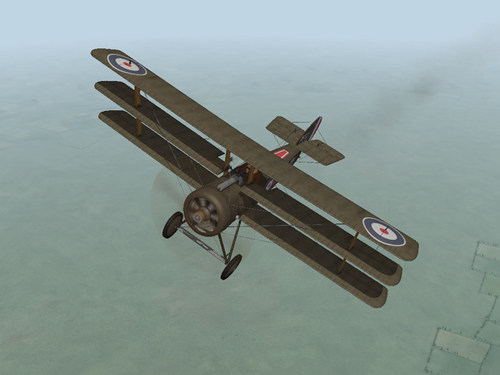
The Sopwith Triplane, also known as the "Tripe" or "Tripehound," was introduced at the end of 1916. By mid 1917, several British and French naval squadrons were equipped with the plane. The narrow chord of the three staggered wings gave the pilot an excellent field of view and gave the plane an exceptional rate of climb as well as outstanding agility. The Triplane was considered an exceptional fighter and stayed in service until replaced by the Sopwith Camel in late 1917. Captured Sopwith Triplanes inspired the development of the more famous Fokker Dr.1.
My model of the Sopwith Triplane has the smaller tail assembly introduced early in 1917. Earlier planes had a larger tail plane nearly identical to the tail of the Sopwith Pup. My plane is equipped with a single Vickers machine gun mounted on the fuselage. A small number of Sopwith Triplanes had two guns.
My Sopwith Triplane has two skins, one French and one British, with appropriate decals. A fully functional cockpit is included, along with my skinning templates. I have included a sound file for the Clerget 130 hp engine, but you may already have it.
Credits
Although he's very busy these days, Ojcar found the time to make the FM. My thanks to him.
The sound file included with this plane came with Sinbad's series of Sopwith Strutters, so you may already have it. I included it with this download in case you don't.
Installation Instructions
For FE1 - Unzip the file and move the folder named "SopwithTriplane" into the FirstEagles/Objects/Aircraft folder.
My Triplane uses the sound file that came with Sinbad's series of Strutters, so you may already have it. If you don't, copy the file named "RotaryEngineClerget130" from my Sounds folder into your FirstEagles/Sounds folder.
For FE2 - Unzip the file and move the folder named "SopwithTriplane" into the FirstEagles/Objects/Aircraft folder. Then in the FirstEagles/Objects/Decals folder, create new folder named "SopwithTriplane". Move the folder named "D" from the Aircraft/SopwithTriplane folder into the Decals/SopwithTriplane folder you just made.
My Triplane uses the sound file that came with Sinbad's series of Strutters, so you may already have it. If you don't, copy the file named "RotaryEngineClerget130" from my Sounds folder into your FirstEagles/Sounds folder.
A new Snipe

The Sopwith Baby was a British, single seat float plane used for reconnaissance and light bombing. It was built in fairly large numbers and was used by the British, French, Italian, Australian, Canadian, and American navies.
My version carries a Lewis machine gun on the upper wing and a has a loadout for a light bomb load. Some Babys had a Lewis gun mounted at an angle through the upper wing and some had a synchronized Lewis mounted on the fuselage, but the horizontal upper wing mount seems to have been the most common.
Since it's a float plane, the Sopwith Baby works best in the Flanders, Gibraltar or other terrain that has a lot of water. Ojcar has done a great job making this plane take off and land realistically on water.
The plane will actually take off and land from a conventional airfield, but it looks strange to see the floats going under the ground. It would be best to start the missions in the air.
I have included two skins, a generic olive skin for France and Britain, and an Italian linen skin. A full set of decals are included with Italian insignia and (fictitious) serial numbers. My skinning templates are included with the download.
Credits
Thanks to Ojcar for making the data file for the Sopwith Baby.
Thanks to Nix for providing the sound for the engine.
Installation Instructions
For FE1 - Unzip the file and move the folder named "SopwithBaby" into the FirstEagles/Objects/Aircraft folder. You also need to move the sound file "clerget9b2m2.wav" into the FirstEagles/Sounds folder.
For FE2 - Unzip the file and move the folder named "SopwithBaby" into the FirstEagles/Objects/Aircraft folder. Then in the FirstEagles/Objects/Decals folder, create new folder named "SopwithBaby". Move the folder named "D" from the Aircraft/SopwithBaby folder into the Decals/SopwithBaby folder you just made. You also need to move the sound file "clerget9b2m2.wav" into the FirstEagles/Sounds folder.

The French had three versions of the Strutter. The 1A2 for recon and artillery spotting, and two bombers, the 1B2, which carried a gunner, and the 1B1 which had only the pilot. The French prioritized delivery of the 1A2. The 1A2 Strutters, like the English 9400 series, had a fuel tank between the pilot and the observer. Consequently the 1A2 had greater range than the 1B2 and 1B1, which carried internal bomb bays in that same area.
France began building Strutters under license in April 1916 to replace obsolete Farmans and Caudron G-4s. As the first French built Strutters were tested ten months later in February 1917, a 1B2 Strutter broke up in mid air. The British insisted over stressing by the pilot caused the crash but the French demanded a total design review. The review resulted in few changes, but French built Strutters were not put into combat until the Spring of 1917, when they were significantly outclassed by enemy aircraft.
Bombing squadrons were routinely equipped with a mix of the 1B2 and 1B1 variants. and the 1B2 was often used to escort the 1B1. I find no evidence that the French mounted any external stores on the 1A2 or either of the 1B Strutters.
The French produced approximately 4,500 Strutters through April 1918. Some American units were provided with French built Strutters, which they intensely disliked, in part because they were initially delivered without weapons. All versions of the Strutter had air brakes on the inboard lower wings, which are not operational on the model; these brakes were often not favored by the aircrews because they created “mushy” handling. Many pictures of Strutters nosed over, perhaps document this characteristic.
The flight models attempt to reflect the known variations in the French aircraft.
The windscreens on French Strutters were different (some would say more graceful) than the British. That, unfortunately has not been modeled in this version. Dagaith, my original partner in this project left to join the army before the 1A2 model was started. Perhaps one day I will become sufficiently adept with 3dMax to make the adjustment, but that is not possible today. I'd love to have some help with that, if there is someone interested who can make 3dMax sing and dance.
We may eventually have a 1B1 Strutter, but, meanwhile there are production delays. . .
Thanks to Dagaith for the original model, Peter01 for the flight model, Laton for the additional LODs, , Gustav for conseils français, as well as beta testing by Southside Bucky (for the original English versions) Panama Red and Ojcar, who prompted me to get this bird out of the coop.
The included skin sets for the 1A2 depict aircraft flown by two French Escadrille, Sop 226, with silver dope and Sop 284, which operated 10 camo 1A2s from March 1918, the date the unit was formed, until the end of the war. Some sources incorrectly depict the Esc 226 aircraft in clear doped linen or light yellow dope, a mistake I made before discovering more recent and authoritative information. There are two files sets, on for FE2 and another for all previous versions of FE. Just drop them in and go.
sinbad 3 Nov 2010

The Sopwith 1 ½ Strutter is a teameffort. Dagaith began the project early in 2009 and I joined to helpwith research and skins. Unfortunately, his commitment to quality,and the pressure of time, made it impossible for Dagaith to finishthe 3d model before he was drafted into the army (Estonia) in June. Icontinued work on the cockpit and skins, but I was unable to make thefinal adjustments and generate the LOD files necessary for game play.[Dagaith used a later version of 3dMax that would not render in theversion I have.] Fortunately Laton completed the LODsand made it possible to get the Strutter ready for game play. Theflight model was done by Peter01, the gunner by P10ppy. The finalcockpit and skin sets are my efforts. Southside Bucky did Betatesting and offered valuable advice to tune up the model and skinsfor release.
Skins in highdefinition (2048 x 2948) and standard definition ((512 x 512) will bereleased along with the model. A hidef set for B Flight 43 Squadron RFC is enclosed as the default.Additional skins are available in the download section. The2048 and 512 skin sets are NOT interchangeable. You may reduce the hidef set down to 1024, but if you do, keep the associated decal sets.Because some detail could only be sustained by decals in the standarddef sets, these are different from the hi def sets.
There is an sound file with the 130 HP Clerget for your sound folder.
The Strutter was the first British aircraft with a synchronized Vickers gun. There were several versions. The first a two seat observation type, wasknown to the RNAS and the RFC as the 9400 series, and later to theFrench as the 1A2. The 9400 is the version modeled here. A later single seat version, adapted for bombing, called the 9700 series was first produced for the UK. The French not only built both versions, but made about twice as many (4500) as the British. The first French bomber versions were identified as 1B2 (with a crew of 2). The later French versions, similar to the 9700, were called 1B1 (a crew of just one). The 1B2 version will be released for First Eagles after this model. The 1B1/9700 type may come later. There was another variant, a single seat interceptor, used for Home Defense of the London area.,which was fitted with one or two Lewis guns and a cockpit aft of the wings, where the gunner was originally placed. All versions had air brakes on the inboard lower wings which are not operational on the model, and were often not favored by the aircrews because they created “mushy” handling.
A substantial set of skins will be released in conjunction with this model. Please refrain from posting additional skins until all of the original skins are posted.
Standard res 512 RFC and RNAS; Belgian 9400 series, French 1A2 and 1B2 all in the pipeline. They will be up ASAP.
Thanks for your patience.
sinbad
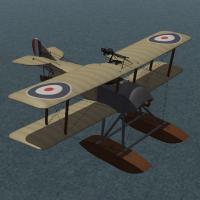
The Sopwith Schneider was the floatplane variant of the Tabloid, and won the Schneider racing trophy in 1914. It was quickly adopted by the British military and was used by the Royal Navy throughout the war. Early versions used wing warping instead of ailerons. Some were armed with Lewis guns on the upper wing and could carry small bomb loads. The Schneider was used mostly for recon, some were used to intercept Zeppelins over the North Sea and some were used to attack land based targets.
Since it's a float plane, the Sopwith Schneider works best in the North Sea terrain, or in Flanders, Gibraltar or other terrain that has a lot of water. The plane will actually take off and land from a conventional airfield, but it looks strange to see the floats going under the ground. Ojcar has included take off instructions in a separate text file.
I have created two skins, an early version with the British flag on the wings, and a later version with roundel markings. I have included a set of number decals. My skinning templates are included with the download.
Credits
Thanks to Ojcar for making the data file for the Sopwith Schneider and for providing instructions for taking off.
Thanks also to Nix for creating the sound file for the Gnome 100hp engine.
Installation Instructions
For FE1 - Unzip the file and move the folder named "SopwithSchneider" into the FirstEagles/Objects/Aircraft folder. You also need to move the sound file "gnome100m2.wav" into the FirstEagles/Sounds folder.
For FE2 - Unzip the file and move the folder named "SopwithSchneider" into the FirstEagles/Objects/Aircraft folder. Then in the FirstEagles/Objects/Decals folder, create new folder named "SopwithSchneider". Move the folder named "D" from the Aircraft/SopwithSchneider folder into the Decals/SopwithSchneider folder you just made. You also need to move the sound file "gnome100m2.wav" into the FirstEagles/Sounds folder.
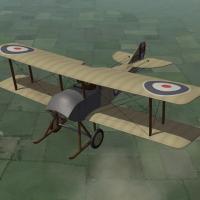
The Tabloid was the land based variant of the Schneider developed in 1913. It was quickly adopted by the British military and was used both by the Royal Navy and the Royal Flying Corps. Early versions used wing warping instead of ailerons. My version has no gun, but some were armed with Lewis guns on the upper wing and could carry small bomb loads. The Tabloid was used mostly for recon and light bombing. In September 1914, Tabloids of the RNAS bombed the Zeppelin sheds at Düsseldorf.
An unlicensed copy known as the Lebed VII was built by the Russians and used for recon and later for training.
I have created two skins, a British version and a Russian. I have included a full set of number decals for each. My skinning templates are included with the download.
Credits
Thanks to Ojcar for making the data file for the Sopwith Tabloid and for providing input on the model details.
Thanks also to Nix for creating the sound file for the Gnome 100hp engine.
Installation Instructions
For FE1 - Unzip the file and move the folder named "SopwithTabloidEarly" into the FirstEagles/Objects/Aircraft folder. You also need to move the sound file "gnome100m2.wav" into the FirstEagles/Sounds folder.
For FE2 - Unzip the file and move the folder named "SopwithTabloidEarly" into the FirstEagles/Objects/Aircraft folder. Then in the FirstEagles/Objects/Decals folder, create a new folder named "SopwithTabloidEarly". Move the folder named "D" from the Aircraft/SopwithTabloidEarly folder into the Decals/SopwithTabloidEarly folder you just made. You also need to move the sound file "gnome100m2.wav" into the FirstEagles/Sounds folder.

The Tabloid was the land based variant of the Schneider developed in 1913. It was quickly adopted by the British military and was used both by the Royal Navy and the Royal Flying Corps. Later versions had ailerons on both wings and a larger vertical stabilizer on the tail. Most were armed with Lewis guns on the upper wing and could carry small bomb loads. The Tabloid was used mostly for recon and light bombing missions. I have included my skinning templates and a full set of number decals.
Credits
Thanks to Ojcar for making the data file for the Sopwith Tabloid and for providing input on the model details.
Thanks also to Nix for creating the sound file for the Gnome 100hp engine.
Installation Instructions
For FE1 - Unzip the file and move the folder named "SopwithTabloidLate" into the FirstEagles/Objects/Aircraft folder. You also need to move the sound file "gnome100m2.wav" into the FirstEagles/Sounds folder.
For FE2 - Unzip the file and move the folder named "SopwithTabloidLate" into the FirstEagles/Objects/Aircraft folder. Then in the FirstEagles/Objects/Decals folder, create new folder named "SopwithTabloidLate". Move the folder named "D" from the Aircraft/SopwithTabloidLate folder into the Decals/SopwithTabloidLate folder you just made. You also need to move the sound file "gnome100m2.wav" into the FirstEagles/Sounds folder.











